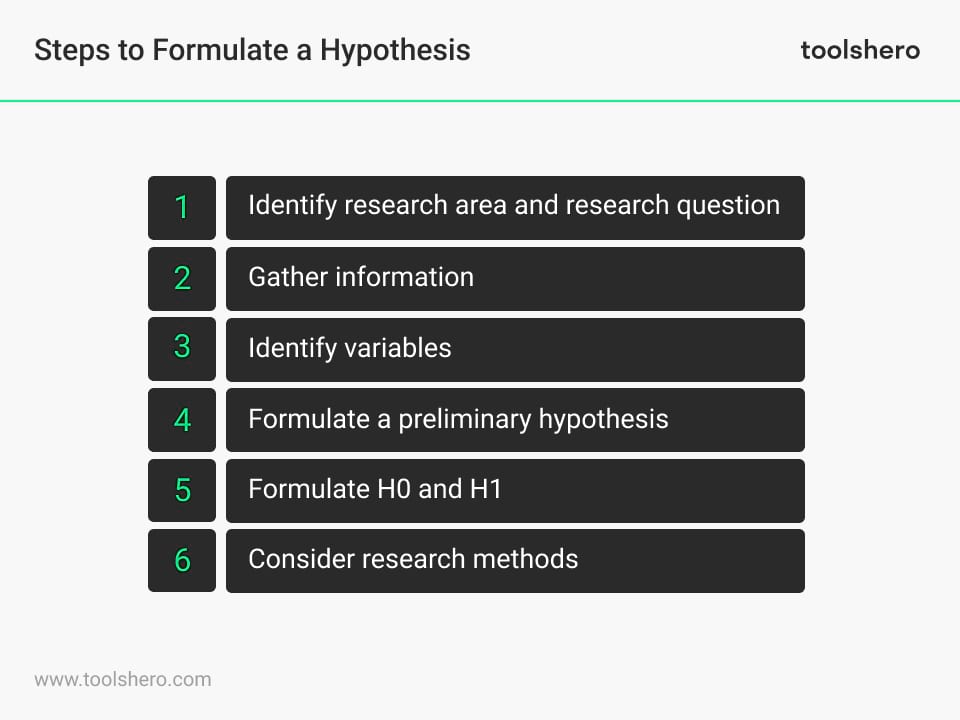Hypothesis: definition and guide

Hypothesis: this article explains the concept of hypothesis in a practical way. The article begins with the definition of this term, followed by a general explanation of hypotheses and when they are used. You will also find a step-by-step plan. Enjoy reading!
What is a Hypothesis?
Definition of Hypothesis
A hypothesis is a preliminary statement that is made before conducting a study. It serves as a possible explanation for the phenomenon under investigation, or as an expectation of the results that will be obtained during the investigation.
Hypotheses are used in various types of research, such as experiments, correlation studies, or observational studies.
Why are hypotheses used in scientific research?
It is used because they often play a vital role in scientific investigations. That is for the following reasons:
Direction and focus
It provides direction and focus for the researchers. It helps them to develop specific questions and to formulate targeted research goals.
Testability
It must be testable, meaning it can be tested and supported or tested and disproved through empirical evidence. This contributes to the validity of the research.
Predictive ability
It makes a prediction about the expected results. This ensures that researchers can better anticipate possible outcomes. It also helps to interpret their findings in relation to the expectations set.
Structure
Formulating a hypothesis helps to structure the research process.
That includes designing experiments, collecting data and analyzing the results. It also provides a framework for drawing conclusions and guiding researchers in making difficult decisions during research.
Examples of hypotheses
Below you will find some examples of hypotheses.
Suppose a researcher is interested in investigating the effects of exercise on individuals’ moods. A hypothesis could then be: regular exercise leads to an improvement in the mood of the participants.
Suppose another researcher investigates whether listening to music while studying has an effect on the student’s learning ability. A hypothesis could then be: students who regularly listen to soothing music while studying will experience an improved learning ability compared to the students who study in silence.
Suppose a researcher is interested in investigating the effects of caffeine on performing a particular task. A hypothesis could then be: consuming caffeine before performing a certain task will lead to an increased concentration compared to the participants who don’t consume caffeine.
The above examples are merely hypothetical situations and are not based on existing data or real studies. When formulating a hypothesis, it is important to refer to existing literature and studies to support the hypothesis. You can read more about that in this article.
Research Methods For Business Students Course
A-Z guide to writing a rockstar Research Paper with a bulletproof Research Methodology!
Null Hypotheses and Alternative Hypotheses
In the context of statistical research, null hypotheses (H0) and alternative hypotheses (H1 or Ha) are used to formulate various possible outcomes or explanations of a study.
The main difference between the two is the direction of the claim they represent.
Null Hypotheses (H0)
A null hypothesis is a statement that states that there is no significant relationship or difference between the variables under investigation.
It is often phrased as a “no effect” or “no difference” statement. The null hypotheses are usually tested to see if they can be disproved using empirical evidence.
For example:
H0: There is no difference in the mean scores of group A and group B.
Alternative hypotheses (H1 or Ha)
An alternative hypothesis is a statement that there is a significant relationship or difference between the variables under investigation.
It can take different forms depending on the researcher’s specific assumptions or expectations. It represents the opposite statement of the null hypotheses and is formulated to explore alternative explanations or outcomes.
For example:
H1: There is a significant difference in the mean scores of group A and group B.
The purpose of formulating null and alternative hypotheses is to make a clear prediction about the expected outcomes of a study and then test these predictions using statistical analysis.
Step-by-step plan for formulating a hypothesis
The steps that one should take in the process of formulating a hypothesis are as follows:
- Identify research area and research question
- Gather information
- Identify variables
- Formulate a preliminary hypothesis
- Formulate the null and the alternative hypothesis
- Consider research methods
The different steps are explained below which can help you in your research proposal and research cycle.

Figure 1 – Steps to formulate a hypothesis
An example is shown below each step.
Step 1: identify research area and research question
Start by identifying the specific area of research you are interested in.
Then formulate a clear research question that you want to answer with your research. The research question must be specific, measurable and relevant.
Example:
Research area: exercise and stress level in students
Research question: does regular exercise reduce stress in students?
Step 2: gather background information
Conduct a literature study to gather existing knowledge on the topic.
Read relevant scientific articles, books, research papers, and other resources to gain insight into existing theories, findings, and debates related to your topic.
This helps to lay a foundation and understand which variables are relevant to your research.
Example:
Conduct a literature study to learn more about the relationship between exercise and stress levels in college students.
You might discover, for example, that exercise can help reduce stress and promote mental well-being.
Step 3: identify the independent and dependent variables
Determine the variables you want to investigate and define them clearly.
The independent variable is the factor that you suspect has an effect on the dependent variable.
The dependent variable is the result or outcome that is affected by the independent variable.
Example:
Independent variable: physical activity (e.g. number of weekly sports activities)
Dependent variable: stress level (measured, for example, using a standardized stress questionnaire)
Step 4: formulate a preliminary hypothesis
Based on your literature review and knowledge of the subject, you formulate a preliminary hypothesis that reflects your expectations or predictions.
The hypothesis must represent a relationship or difference between the independent and dependent variables. Make sure the hypothesis is falsifiable and that your prediction is specific enough to be tested.
Example:
Preliminary hypothesis: regular exercise leads to a reduction in stress levels in students.
Step 5: formulate the null hypothesis and the alternative hypothesis
The null hypothesis (H0) states that there is no significant relationship or difference between the variables. The alternative hypothesis (H1 or Ha) states that there is a significant relationship or difference.
Formulate both hypotheses in a clear and concise manner.
Example:
Null hypothesis (H0): there is no significant difference in stress levels between students who exercise regularly and those who do not.
Alternative hypothesis (H1): students who exercise regularly show a significantly lower stress level than students who do not.
Step 6: consider the research method
Consider which research method is best suited to test your hypothesis. This can range from experiments to observational studies, surveys or other methods.
Think about the necessary data collection techniques and analysis methods needed to test your hypothesis.
Example:
You might decide to conduct an observational study in which students are divided into two groups: a group that does regular physical activity and a group that does not.
You then measure the stress level of both groups using a standardized questionnaire. Then the collected data is analyzed to determine if there is a significant difference in stress level between the groups.
Now it’s your turn
What do you think? Do you recognize the explanation of the hypothesis? Have you ever formulated one for research, such as a thesis? What do you think are important features of a good hypothesis? What do you find difficult? Were you familiar with the differences between a null and an alternative hypothesis? Do you have tips or other comments?
Share your experience and knowledge in the comments box below.
More information
- Barick, R. (2021). Research Methods For Business Students. Retrieved 02/16/2024 from Udemy.
- Hartwick, J., & Barki, H. (1994). Hypothesis testing and hypothesis generating research: An example from the user participation literature. Information Systems Research, 5(4), 446-449.
- Toledo, A. H., Flikkema, R., & Toledo-Pereyra, L. H. (2011). Developing the research hypothesis. Journal of Investigative Surgery, 24(5), 191-194.
- Verhoeven, N. (2007). Doing research. The Hows and Whys of Applied Research.
How to cite this article:
Janse, B. (2023). Hypothesis. Retrieved [insert date] from Toolshero: https://www.toolshero.com/research/hypothesis/
Original publication date: 06/19/2023 | Last update: 01/02/2024
Add a link to this page on your website:
<a href=”https://www.toolshero.com/research/hypothesis/”> Toolshero: Hypothesis</a>












